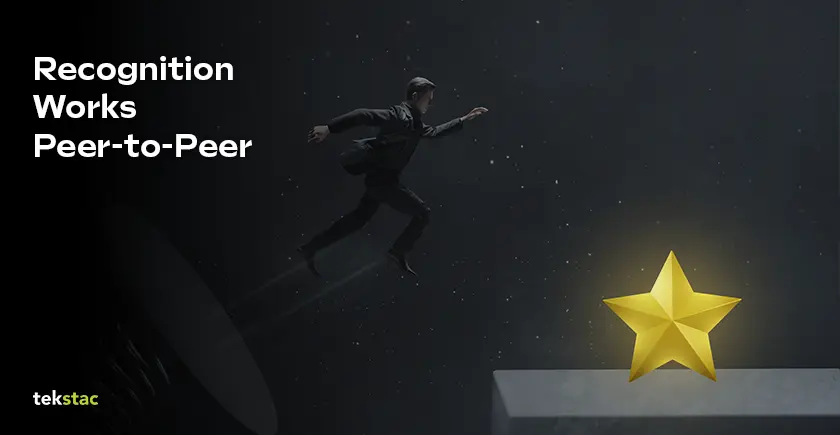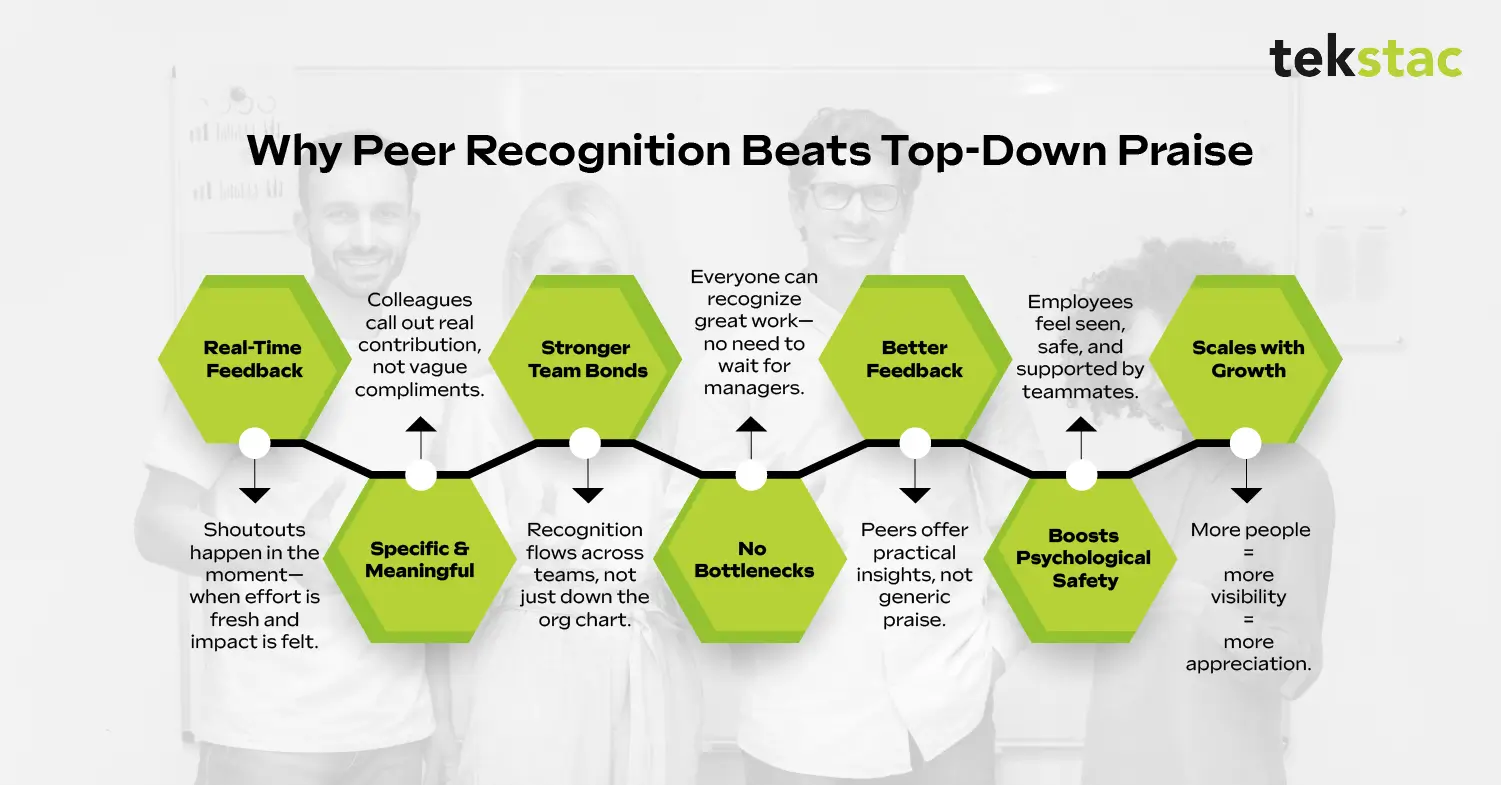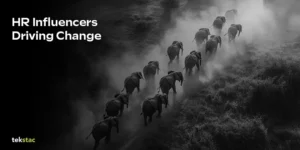Why Peer-to-Peer Recognition Outperforms Top-Down Praise in 2025

How many times have you gotten praise at work that didn’t quite hit right?
Like it was from someone who didn’t really see the effort you put in — or the struggles you faced. That’s the most common experience with traditional top-down recognition, which misses the mark because it’s distant, generic, or delayed.
In fact, as per Gallup, only 23% of employees strongly agree they feel recognized at work. That means nearly 8 out of 10 people feel overlooked, despite all the hard work they put in.
The traditional form of recognition is off and ineffective. Our way of recognizing employees is stuck in the past, being outdated and out of sync with how work actually gets done today. What we need is something real and immediate, coming from people who see the hard work and impact of work every single day. That something is peer-to-peer recognition.
What is Peer-to-Peer Recognition?
Peer-to-peer recognition is when employees recognize each other’s work, contributions, and skills. They recognize publicly and directly, without waiting for a manager or a leader to do it. It’s that shout-out from the teammate who saw you stay late just to get that project done. Or a quick thanks from a coworker who knows exactly how much time you saved them.
Unlike the usual top-down praise, peer recognition happens right then and there. It feels real because it’s coming from people who get the work you do. It’s less about formal awards and more about everyday moments that add up to a culture where everyone feels seen and appreciate among the people they work.
Top-Down Recognition: Why It’s Losing Its Edge
Top-down praise has been the traditional way workplaces recognize achievements for decades. It flows from management down through the organizational hierarchy, and this model is currently showing its age. What once seemed like the natural order of workplace acknowledgement now feels increasingly disconnected from the real work happening on the ground.
Picture this: a manager who’s not involved in the daily grind gives praise based on a quarterly review or what they heard from someone else. The timing’s off. They don’t really get the full picture. So when the praise finally comes, it feels more like formality than real thanks.
This model can also result in a system where employees look up for approval rather than around for collaboration. If we look around, the modern workplace doesn’t operate in typical hierarchical lines anymore. Projects across departments, teams form and dissolve based on need, and some of the most valuable contributions happen in the spaces between job descriptions. Yet our recognition systems remain stuck in an organizational chart that doesn’t reflect how work actually flows.
Furthermore, managers have limited bandwidth, making recognition another item on an already crowded to-do list. What should be immediate and genuine becomes scheduled, hence organizations are now shifting towards peer-to-peer recognition.
Peer Recognition: 7 Tangible Benefits Over Top-Down
The shift we’re seeing, from hierarchical praise to peer recognition, is not a trend; rather, it delivers measurable advantages that traditional top-down systems simply cannot match.

1. Immediate Context and Relevance
Peer recognition operates on the principle of proximity, as colleagues work alongside each other, see the real challenges, and witness the actual problem-solving process. Hence, peer to peer recognition naturally addresses specific contributions rather than broad performance categories. In contrast, traditional top-down recognition operates at a remove from the actual work. When received, it tends toward the general rather than the specific, simply because they lack the granular visibility that peers possess.
2. Authentic Timing
Recognition loses power when it’s delayed. Acknowledgement hits hardest when it comes right after the win, while the effort is still fresh. That’s why peer-to-peer shoutouts work so well. They happen naturally, in the moment, not because some formal process says they have to. This immediacy also means that recognition can influence ongoing work, encouraging continued collaboration and excellence within the same project cycle.
Hence, this trumps traditional recognition models as they operate on scheduled intervals or formal recognition ceremonies. By the time these moments arrive, the specific contributions have faded into broader performance assessments.
3. Builds Horizontal Relationships
Most companies focus on the relationships between managers and their teams. However, while this is important, it is only one way how people can connect at work. When colleagues recognize each other directly, it creates a different kind of connection, where recognition runs across teams, rather than just up and down the chain of command.
Top-down recognition is helpful, but it doesn’t do much to strengthen peer relationships. In fact, it can sometimes create competition for managerial attention rather than create connections between employees.
4. Reduces Recognition Bottlenecks
Managers, regardless of their good intentions, have limited scope and imperfect visibility into all the work happening within their teams. They become single points of failure in the recognition system. When they’re busy, distracted, or simply unaware of specific contributions, recognition doesn’t happen at all. This leaves team-wide recognition gaps, leaving some types of contributions undervalued.
Peer recognition distributes this responsibility across the entire team, where every team member becomes a potential source of recognition. This way, good work gets seen and appreciated more often. It also means that one person’s effort can get a shoutout from different people, each noticing something unique about what they did.
5. Encourages Specific, Actionable Feedback
The best recognition does more than acknowledge past performance and provides insight that can improve work. Peer recognition works best because coworkers really get the details. They understand the work and can give feedback that actually helps. They don’t just say what was good — they explain why it mattered and how it made a difference. This detailed feedback creates a continuous learning environment where recognition and employee development support each other.
Top-down praise leans toward broad categories, such as “great teamwork” or “excellent results,” without the details that make feedback useful for performance improvement. This fails to provide guidance that helps employees understand and replicate their successes.
6. Creates Psychological Safety
Psychological safety means feeling like you can speak up without fear of being judged. It’s what makes teams work well. When peers recognize each other, it helps build that safety. When your teammates notice and appreciate your work, it makes it easier to take risks, ideas, and admit when things go wrong. This support helps employees stop worrying about being judged, and instead helps focus on doing their best.
Also, recognition from managers is importance, but it doesn’t always build the same sense of psychological safety peer recognition does. While employees welcome praise from their supervisors, which still works within a hierarchy, they can feel anxiety about performance rather than gaining the confidence needed to improve at work.
7. Scales Naturally with Team Growth
As teams grow, traditional recognition systems become increasingly difficult to maintain effectively. Managers have more direct reports to track, more contributions to notice, and more relationships to manage. The quality and frequency of recognition often decline as team size increases as well.
Peer recognition actually works better as teams get bigger. More people mean more chances for good work to get noticed, more ways to appreciate different skills, and more chances to give shoutouts. The whole system gets stronger the more it grows. This really matters when teams often change, grow, shrink, or shift around for different projects. Old-school recognition systems don’t keep up well with these changes because they rely on fixed bosses and reporting lines.
Recognition Redesigned for Modern Teams
As discussed, traditional top-down recognition systems are failing modern teams, unlike the peer recognition model that delivers immediate, specific, and meaningful acknowledgement that drives performance. The main challenge is that peer-to-peer recognition requires the right conditions, visibility into each other’s work, shared experiences, and systems that naturally encourage feedback. Without these foundations, even the best intentions around recognition fall flat.
This is where strategic learning programs become essential. This is where you create conditions where people learn together, grow together, and develop skills as a team, so peer-to-peer recognition becomes a natural byproduct. First, let’s get the fundamentals right.
Ready to see this in action? Discover how Tekstac enabled a fortune 500+ tech company to transform its culture by onboarding and upskilling 40,000+ fresh graduates, creating the visibility, accountability, and cross-team connections that make peer-to-peer recognition thrive.





